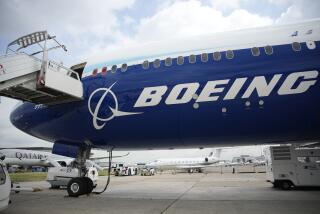Jiang’s Visit Could Pay Off for Hughes
China’s $3-billion deal to buy 50 Boeing Co. jetliners--inked Thursday in a Washington signing ceremony presided over by U.S. Commerce Secretary William Daley--gives a boost to the Seattle-based company that just last week announced it would take a $1.6-billion charge for the quarter.
Absent from the deal were any McDonnell Douglas models made in Long Beach. The lack of orders for MD-11s, MD-80s and MD-90s is another ominous sign for Douglas Aircraft Co., which Boeing obtained when it acquired McDonnell Douglas Aircraft Corp. this summer. Boeing officials have said market forces would determine which planes would remain in production, and the MD-80 and MD-90 are considered extremely vulnerable.
But the Southland aerospace industry could make up for that if Chinese President Jiang Zemin’s visit to Los Angeles-based Hughes Electronics on Sunday results in a big-ticket order for the satellite and telecommunications firm.
Zemin formally announced the Boeing deal--its largest airplane order ever--during his summit with President Clinton on Wednesday. The order includes 36 737s, one 747, five 757s and eight 777s, which are manufactured at Boeing’s plants in the Seattle suburbs of Renton and Everett.
The Chinese order will boost Boeing’s Southern California suppliers, including Leach International Corp. in Buena Park, Square Tool & Machine Co. in El Monte, and Culver City Composites Corp. of Los Angeles.
Zemin’s visit to Hughes has sparked rumors that another deal may be in the offing for the General Motors Corp. unit, although company officials are downplaying that possibility.
“This trip is not a buying trip,” said Gareth C.C. Chang, president of Hughes International. The purpose of the 90-minute visit is to introduce Jiang, an engineer, to the latest technology from Hughes and GM, Chang said.
Hughes is the only company Jiang will visit on the West Coast, and if Jiang doesn’t reveal a surprise deal this weekend, one could certainly be around the corner.
China “certainly has a number of needs that Hughes could satisfy,” said Paul Nisbet, president of JSA Research, an aerospace research firm in Newport, R.I. For instance, he said, Hughes would be a logical supplier of satellite television services or telephone systems.
Those are the kinds of deals Hughes has been making lately with emerging economies. Last month, the company’s Space & Telecommunications International unit signed a $1.2-billion deal with Thuraya Satellite Telecommunications of the United Arab Emirates that would bring mobile phone service to a wide swath of the Middle East. That was followed by a sale last week to a subsidiary of Media Most, a Russian company that is developing satellite television broadcasting services there.
Hughes and China have a particularly close relationship, which goes back to 1972, when Hughes set up antennas and a ground station in Beijing to televise President Nixon’s historic visit there. The company holds 85% of the market for satellite-based network services in China, and Hughes won the bulk of a $640-million contract from a consortium of Chinese and Singaporean companies last year to provide mobile phone service via satellite. Hughes will use China’s Long March rockets for between five and 10 satellite launches.
On a more personal level, former Hughes Chairman C. Michael Armstrong, who recently was named chairman of AT&T; Corp., was an early and vocal lobbyist against a U.S. ban on satellite sales to China in 1993. The ban, imposed after China transferred missile components to Pakistan, was lifted a year later.
Supersonic Research
With a series of NASA-sponsored supersonic flight tests drawing to a close, Boeing is negotiating with NASA’s Russian partner for a way to continue the experimental flights, which provide valuable research data.
NASA and Russia’s Tupolev Design Bureau have been testing a Tu-144 supersonic transport jet as part of NASA’s 2-year-old, $15-million High Speed Research program, which will develop technology that would aid Boeing in building a commercial supersonic plane for transoceanic flights. The Tu-144 has made 10 test flights so far, and the eight remaining flights should be completed by next spring, said Bob Witcofski,, senior aerospace engineer at NASA Langley Research Center in Hampton, Va.
At that point, Boeing--the main contractor for the High Speed Research program--may work directly with Tupolev to continue with more tests, which are being used to validate data that Boeing has derived from computer models.
“We are having discussions about what we might do together,” said Susan Davis, communications manager for engineering and product development in Boeing’s Commercial Airplane Group. “This is an excellent opportunity.”
Boeing began developing a supersonic plane in 1958 but abandoned the project in 1971 after Congress cut off research funding. New technology that would make the planes cheaper, quieter and more environmentally friendly could resurrect the project, although Davis said a Boeing supersonic transport plane is more than 10 years away.
Safety Honors
Aerojet’s design, development and manufacturing facility in Azusa this month became the first aerospace company in the state to receive the Voluntary Protection Program Star rating from the California Division of Occupational Safety and Health. Aerojet, a unit of Fairlawn, Ohio-based GenCorp, is only the eighth California firm to earn Star status since the nationwide program began last year.
The award exempts Aerojet’s Azusa operations from unscheduled Cal/OSHA inspections through 2000, when the company can apply for recertification. The rating was granted after 150 hours of interviews, reviews and inspections, said Rick Rice, deputy director for the Department of Industrial Relations in San Francisco, which oversees Cal/OSHA.
Rice said Aerojet impressed inspectors with an accident rate that is at least one-third below the aerospace industry average and with a high degree of employee and management commitment to their integrated safety plan.
Karen Kaplan covers aerospace, technology and telecommunications. She can be reached at Karen.Kaplan@latimes.com
More to Read
Inside the business of entertainment
The Wide Shot brings you news, analysis and insights on everything from streaming wars to production — and what it all means for the future.
You may occasionally receive promotional content from the Los Angeles Times.











